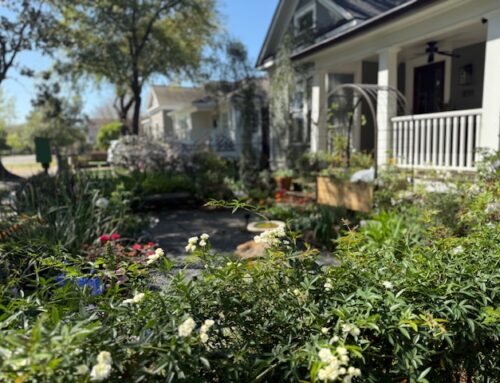Many of us are itching to get out there and clean our gardens. We can’t wait to get rid of those leaves and bare branches. Be careful not to jump into this so quickly though. Keep in mind, our fall and winter gardens are home to many insects and other creatures hibernating and laying their eggs.
Lots of beneficial insects including pollinators like tiny native bees spend the winter in hollow plant stems either as adults or pupae.
If part of your spring garden clean up involves pruning back woody perennials or shrubs, keep a sharp eye out for cocoons and chrysalises. Some of our most beautiful moths and butterflies spend the winter in a delicate cocoon dangling from a branch, including the swallowtails and sulfurs. Allow any branches with a cocoon or chrysalis present to remain intact. You can always cut them back later in the season. If you have a compost pile, you can toss them there or bundle and hang on a fence to allow them to emerge.
It’s a good idea to halt your garden clean up until there is no chance for a hard frost or freeze. Waiting before you trim, toss, bag and compost gives you a better chance of not having damage to your plants.
Trimming roses is usually set for February 14th. This is the perfect time to trim, remove any thin, weak growth, dead wood and fertilize. Try opening up the center of the rose by removing crossing branches, which can rub, causing damage and encouraging disease. Prune by cutting 1/4” to 1/2” above an outward-facing bud eye (a small bump found where a leaf would meet the stem). New stems grow in the direction of the bud and the goal is to encourage them to grow outward, not inward. Make cuts at a 45-degree angle sloping away from the bud, allowing water to run off. Always make sure your pruning shears are clean and sanitized.

Did you know it is not necessary to trim your Crape Myrtles in order for them to bloom? Leaving them natural even with seeds pods is perfectly OK. They will still bloom. If you do trim, please do so only to shape the tree and remove any dead limbs. And don’t forget to remove the suckers coming up at the bottom of the tree. Please, no crape murder.
Trimming your ornamental grasses—Through the winter, we keep the leaves around to enjoy their beauty. This also protects the crown of the plant throughout the winter, but you do want to prune the old growth before the new growth begins. Leaving the dead material on too long can impair the crown’s warming and delay new growth by as long as three weeks. If you delay the haircut until after new shoots have appeared, you’ll want to trim the old material carefully. If you cut the new blades, they’ll have a raggedy, unnatural appearance all season.
This is also a good time to prune your perennials, cutting back any freeze or frost damage. So many plants and shrubs in your garden should be trimmed in spring to encourage new growth. Some that you should wait to trim until after they bloom are – azaleas, magnolias, flowering hydrangeas, Mexican plums, redbud, rhododendron, yesterday-today-and-tomorrow and many more.
The Heights Garden Club wishes everyone a happy springtime of gardening. Keep in touch and we hope to see everyone soon! Check our website regularly, www.heightsgardenclub.org.
















